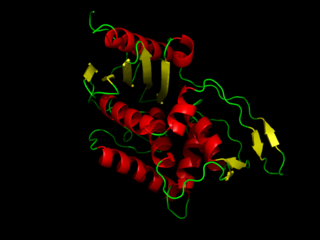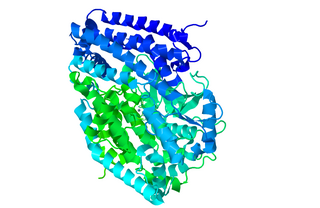Development of first generation ACE inhibitors
The development of the nonapeptide teprotide (Glu-Trp-Pro-Arg-Pro-Gln-Ile-Pro-Pro), which was originally isolated from the venom of the Brazilian pit viper Bothrops jararaca , greatly clarified the importance of ACE in hypertension. However, its lack of oral activity limited its therapeutic utility. [3] [4]
L-benzyl succinic acid (2(R)-benzyl-3-carboxypropionic acid) was described to be the most potent inhibitor of carboxypeptidase A in the early 1980s. The authors referred to it as a by-product analog and it was proposed to bind to the active site of carboxypeptidase A via succinyl carboxyl group and a carbonyl group. Their findings established that L-benzylsuccinic acid is bound at a single locus at the active site of carboxypeptidase A. The authors discussed but dismissed the suggestion that the carboxylate function might bind to the catalytically functional zinc ion present at the active site. Later however this was found to be the case. [3] [5] [6]
Drug design of captopril (sulfhydrils)

Over 2000 compounds were tested randomly in a guinea pig ileum test and succinyl-L-proline was found to have the properties of a specific ACE inhibitor. It showed inhibitory effect of angiotensin I and bradykinin without having any effects on angiotensin II. Then researchers started to search for a model that would explain inhibition on the basis of specific interaction [ disambiguation needed ]s of compounds with the active site of ACE. [5] Previous studies with substrates and inhibitors of ACE suggested that it was a zinc-containing metalloprotein and a carboxypeptidase similar to pancreatic carboxypeptidase A. However ACE releases dipeptides rather than single amino acids from the C-terminus of the peptide substrates. And it was assumed that both their mechanism of action and their active site might be similar. A positively charged Arg145 at the active site was thought to bind with the negatively charged C-terminal carboxyl group of the peptide substrate. It was also proposed that ACE binds by hydrogen bonding to the terminal, non scissile, peptide bond of the substrate. [3]
But since ACE is a dipeptide carboxypeptidase, unlike carboxypeptidase A, the distance between the cationic carboxyl-binding site and the zinc atom should be greater, by approximately the length of one amino acid residue. Proline was chosen as the amino acid moiety because of its presence as the carboxy terminal amino acid residue in teprotide and other ACE inhibitors found in snake venoms. 11 other amino acids were tested but none of them were more inhibitory. So it was proposed that succinyl amino acid derivative should be an ACE inhibitor and succinyl-L-proline was found to be such an inhibitor. [3] [5] [7]
It was also known that the nature of penultimate amino acid residue of a peptide substrate for ACE influences binding to the enzyme. The acyl group of the carboxyalkanoyl amino acid binds the zinc ion of the enzyme and occupies the same position at the active site of ACE as the penultimate. Therefore, the substituent of the acyl group might also influence binding to the enzyme. A 2-methyl substituent with D configuration was found to enhance the inhibitory potency by about 15 fold of succinyl-L-proline. Then the search for a better zinc-binding group started. Replacement of the succinyl carboxyl group by nitrogen-containing functionalities (amine, amide or guanidine) did not enhance inhibitory activity. However a potency breakthrough was achieved by the replacement of the carboxyl group with a sulfhydryl function (SH), a group with greater affinity for the enzyme bound zinc ion. This yielded a potent inhibitor that was 1000 times more potent than succinyl-L-proline. [3] [7] The optimal acyl chain length for mercapto alkanoyl derivates of proline was found to be 3-mercaptopropanoyl-L-proline, 5 times greater than that of 2-mercaptoalkanoyl derivates and 50 times greater than that of 4-mercaptoalkanoyl derivates. So the D-3-mercapto-2-methylpropanoyl-L-proline or Captopril was the most potent inhibitor. Later, the researchers compared a few mercaptoacyl amino acid inhibitors and concluded that the binding of the inhibitor to the enzyme involved a hydrogen bond between a donor site on the enzyme and the oxygen of the amide carbonyl, much like predicted for the substrates. [3] [8]
Drug design of other first generation ACE inhibitors


The most common adverse effects of Captopril, skin rash and loss of taste, are the same as caused by mercapto-containing penicillamine. Therefore, a group of researchers aimed at finding potent, selective ACE inhibitors that would not contain a mercapto (SH) function and would have a weaker chelating function. They returned to work with carboxyl compounds and started working with substituted N-carboxymethyl-dipeptides as a general structure (R-CHCOOH-A1-A2). According to previous research they assumed that cyclic imino acids would result in good potency if substituted on the carboxyl terminus of the dipeptide. Therefore, substituting A2 with proline gave good results. They also noted that according to the enzyme's specificity imino acids in the position next to the carboxyl terminus would not give a potent compound. By substituting R and A1 groups with hydrophobic and basic residues would give a potent compound. By substituting –NH in the general structure resulted in loss of potency which is consistent to the enzyme's need for a –NH in corresponding position on the substrates. The results were 2 active inhibitors: Enalaprilat and Lisinopril. These compounds both have phenylalanine in R position which occupies the S1 groove in the enzyme. The result was thus these two new, potent tripeptide analogues with zinc-coordinating carboxyl group: Enalaprilat and Lisinopril. [1] [9]











